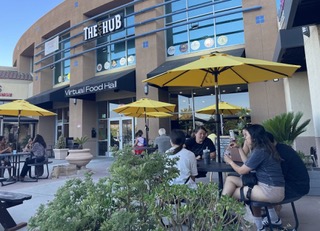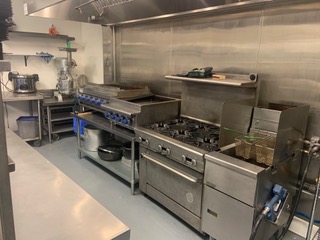Santa Clarita Valley Kitchens, or The SCV Hub, is focused on enhancing its delivery and digital ordering experience to drive business growth.
The SCV Hub is a 10,000-square-foot virtual food hall featuring various food brands in Southern California. Guests can order from one or multiple restaurants at the same time via kiosks. There are also options to order ahead for pickup or delivery. The area features some indoor and outdoor seating.
“We built 18 separate commercial kitchens, similar to Kitchen United or Cloud Kitchens,” said Chris Collins, The SCV Hub co-founder. “We started with 12 restaurants, eight of which were new startups.”

Santa Clarita Valley Kitchens or “The SCV Hub” is a 10,000-square-foot virtual food hall featuring various food brands.
Collins noted that some initial restaurants ultimately closed since the food hall first opened last year. “The restaurant business is tough; it’s not for everyone.” However, he adds that the current brands are finding success. The food hall features eight brands, including Los Tacoholics, Blossoms Sweet Kitchen and Mississippi Georgia Fried Soul Food—to name a few.
One of the brands, Keto Sweets, mainly uses its Hub kitchen for off-site baking and sells at farmers’ markets and festivals. Additionally, the Hub is looking to create an in-house brand tailored to kids’ cravings such as burgers and fries.
Enhanced digital ordering
With goals to grow the business, Collins said they recognized a need for better management of its ordering and delivery. Drawing inspiration from Oomi Digital Kitchen’s operations, Collins decided to partner with Empower Delivery.
“Our multi-brand ordering experience allows a consumer to place an order across brands on a single kiosk transaction or a single online transaction if they want to order ahead for pickup or delivery,” said Meredith Sandland, CEO of Empower Delivery.
Empower’s system also runs the kitchen display system (KDS) that brings all of the orders together at the same time, regardless of what kitchen they were prepared in.
“The software also permits payments from the consumers, which might have been a multi-brand order, back to each operator,” she said.
Delivery fulfillment
On the delivery end, the software enables on-demand, direct delivery.

The SCV Hub features 18 commercial kitchens.
“Even if restaurants can get consumers to order directly [or first-party], they still need to fulfill those orders,” said Sandland. She added that options outside of major pizza chains with W-2 drivers are limited, leaving operators to rely on third-party services like DoorDash or Uber Eats.
“The challenge with that is timing the arrival of the driver. So typically the food is either sitting waiting and degrading, or the driver is sitting and wasting time, which is not good for the driver’s economics or for the network’s economics,” she said.
The system includes “smart fire times” for the back-of-house kitchen. This informs employees of the right time to start cooking for a swift handoff with the driver. Drivers are paid per delivery, not hourly and the software matches them in real time without them being on payroll.
Looking ahead, The SCV Hub is eyeing an ordering feature for office workers and is eager to get the word out about the food hall to newcomers.
“The [food hall] concept is very new to most people who come in; they often have a puzzled look on their faces, like, ‘What is this?’ We explain it to them, and then they sit there and go, ‘Wow, that’s awesome. That’s a great idea.’ That’s where we see the potential going forward. They love the idea of mixing and matching different restaurants in a single order, whether picking it up or having it delivered,” said Collins.
He’s onto something. As Sandland adds, “Consumers crave convenience,” also noting that delivery is here to stay.
“I think as we figure out how to bring the cost of delivery down with things like dedicated on-demand delivery, delivery will continue to grow,” she said.


